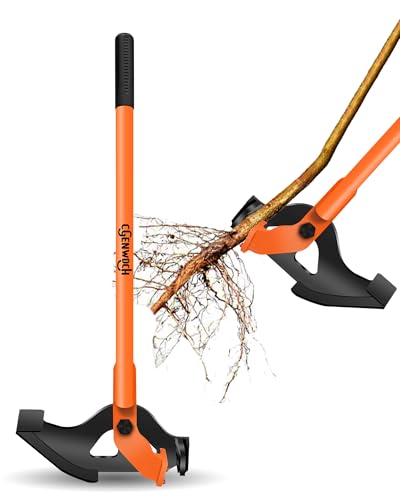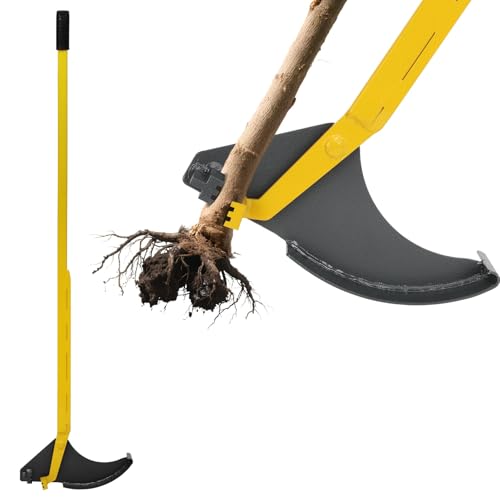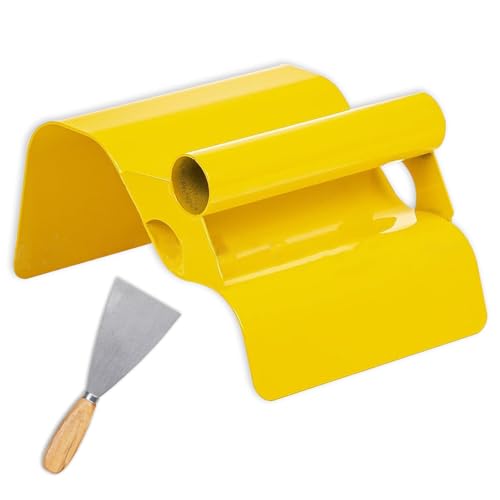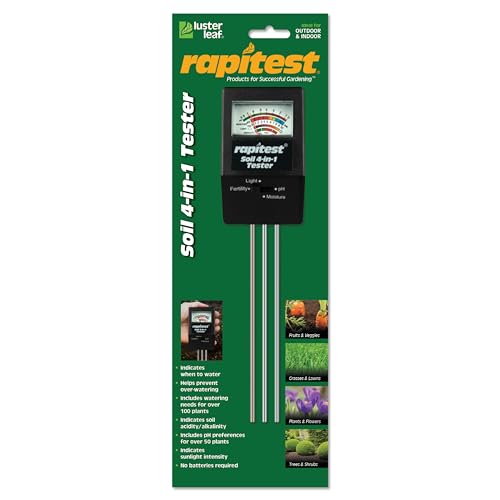Best Uproot Root Puller
Tired of battling stubborn weeds that keep popping back up? Achieving a pristine lawn or garden often hinges on effectively removing weeds at their source – the roots.
That’s where a quality uproot root puller becomes an indispensable tool. However, navigating the market for the best uproot root puller can be overwhelming, with countless options promising effortless weed removal.
Choosing the right tool is crucial, impacting not only the efficiency of your weeding efforts but also the long-term health and appearance of your outdoor space. This article aims to guide you through the key considerations, helping you select the best uproot root puller that balances performance with value and durability.
We understand the importance of making an informed decision, saving you time, money, and frustration in your ongoing battle against unwanted vegetation.
IN THIS ARTICLE
Top 10 Best Uproot Root Puller Compared

🏆 BEST OVERALL CGENWDCH Large Size Sapling Puller
- Effective removal of small trees and weeds with root ball.
- Sustainable and safe, avoids chemicals and noisy machinery.
- Lever design reduces user fatigue.
- Durable construction with rust-resistant coating.
4.7/5
Check Price on Amazon

🥈 2ND RUNNER UP Walensee Weed Puller
- Eliminates bending and kneeling, reducing back and knee strain.
- Three-claw design effectively grips weed roots.
- Foot pedal provides leverage for easier ground penetration.
- Potentially durable stainless steel construction.
4.4/5
Check Price on Amazon

� BEST VALUE CGENWDCH Small Size Sapling Puller
- Effectively removes small trees and weeds along with their roots.
- Lever design reduces user fatigue.
- Durable construction with rust-resistant coating.
- Eliminates the need for chemicals or motorized equipment.
4.4/5
Check Price on Amazon

Walensee Upgraded Weed Puller
- Long handle reduces back strain.
- Foot pedal assists with ground penetration.
- Five-claw design for effective root removal.
- Durable, rust-resistant construction.
4.5/5
Check Price on Amazon

WORKPRO Weed Puller Tool
- Durable stainless steel construction.
- Ergonomic handle for comfortable grip.
- Lightweight and easy to maneuver.
- Hanging hole for convenient storage.
4.5/5
Check Price on Amazon

Weed Puller,Stand-Up Weeding Picker Tool
- Eliminates bending and kneeling, reducing back and knee strain.
- Durable metal construction ensures longevity.
- Environmentally friendly by avoiding chemical herbicides.
- Easy to assemble and store with its removable pole design.
4.5/5
Check Price on Amazon

Heavy-Duty Tree Puller
- Effective root removal to prevent regrowth for suitable plants.
- Durable steel construction with rust-resistant coating.
- Lever design aims to reduce user effort and strain.
- Eco-friendly alternative to chemicals and chainsaws.
4.8/5
Check Price on Amazon

Garden Guru Root Weeder Tool with Ergonomic Handle – Stainless Steel Weed Puller for Planting
- Effective three-tined design for removing weeds by the root.
- Durable and rust-resistant stainless steel construction.
- Ergonomic handle designed for comfortable grip and reduced hand fatigue.
- Environmentally conscious production with carbon neutral certification and donations to environmental causes.
4.6/5
Check Price on Amazon

ORIENTOOLS Weed Puller Stand Up Weeder Hand Tool with 3 Claws for Dandelion
- Eliminates the need to bend or kneel, reducing back strain.
- Durable powder-coated steel construction for rust resistance.
- Simple and easy to operate with no assembly required.
- Effective for removing various types of weeds.
4.4/5
Check Price on Amazon

Colwelt Weed Remover Tool 39’’
- Reduces back strain by allowing weeding from a standing position.
- Foot ejector simplifies weed removal from the tool.
- Steel construction provides durability and rust resistance.
- Includes hand weeder and gloves for added versatility.
4.5/5
Check Price on Amazon
Detailed Reviews of the Best Uproot Root Puller
CGENWDCH Large Size Sapling Puller – Effective removal of small trees and weeds with root ball.

This sapling puller is designed to remove small trees and weeds, claiming to eradicate them permanently by pulling out the root ball. It handles stems from 1/4″ to 2″ in diameter. The tool emphasizes a safe and sustainable removal process, avoiding chemicals and noisy machinery, which is a plus for environmentally conscious users.
Its lever design aims to reduce user fatigue, allowing for extended use. Built with heavy-duty metal and a powder coating, it appears durable and resistant to rust. The puller is best suited for shrubs, thorns, and saplings, but it’s noted as less effective on root-sucking plants unless the mother plant is also removed.
Performance is improved in slightly moist soil. Overall, it seems a reasonably robust tool for targeted plant removal.
Pros
- Effective removal of small trees and weeds with root ball.
- Sustainable and safe, avoids chemicals and noisy machinery.
- Lever design reduces user fatigue.
- Durable construction with rust-resistant coating.
- Suitable for a range of invasive plants like shrubs and thorns.
Cons
- Not effective on root-sucking plants unless the mother plant is removed.
- Effectiveness is dependent on soil moisture.
Walensee Weed Puller – Eliminates bending and kneeling, reducing back and knee strain.

This stand-up weeding tool aims to simplify weed removal, reducing strain on your back and knees. The 39-inch handle provides leverage, and the foot pedal assists in driving the three-claw design into the soil. The steel teeth are designed to grab roots, minimizing regrowth.
While effective on various weed types like crabgrass and thistle, the tool’s performance is best on moist soil. It is constructed from what seems to be durable steel. It’s a potentially helpful tool for gardeners seeking a more comfortable weeding experience, especially those with mobility limitations.
The manufacturer emphasizes that the product will work best if the land is moist and advises against using it in gravelly soil.
Pros
- Eliminates bending and kneeling, reducing back and knee strain.
- Three-claw design effectively grips weed roots.
- Foot pedal provides leverage for easier ground penetration.
- Potentially durable stainless steel construction.
Cons
- Performance is limited in dry or gravelly soil.
- Effectiveness may vary depending on the type of weed and soil compaction.
CGENWDCH Small Size Sapling Puller – Effectively removes small trees and weeds along with their roots.

The sapling puller is designed for removing small trees and weeds with stem diameters ranging from 1/4″ to 3/4″. It aims to provide a permanent solution by extracting the entire root ball, preventing regrowth. The tool operates on a lever principle, intended to reduce user strain, making it accessible even for extended use or for individuals with less strength.
Constructed from heavy-duty metal with a powder coating, it appears durable and resistant to rust. It’s designed for removing invasive plants, shrubs, and saplings, but is less effective on plants that root-suck from a mother plant. Performance is improved when the ground is slightly moist.
Pros
- Effectively removes small trees and weeds along with their roots.
- Lever design reduces user fatigue.
- Durable construction with rust-resistant coating.
- Eliminates the need for chemicals or motorized equipment.
- Suitable for removing invasive species without harming surrounding vegetation.
Cons
- Not suitable for plants that propagate via root suckers.
- Effectiveness depends on soil moisture.
Walensee Upgraded Weed Puller – Long handle reduces back strain.

The Walensee stand-up weeding tool aims to eliminate the back strain associated with traditional weeding methods. Its 38-inch handle and foot pedal design allows for upright operation, reducing the need to bend or kneel. The five-claw design, featuring 2.75-inch steel teeth, is intended to penetrate various soil types and effectively remove weeds, roots and all.
The tool is constructed with a zinc-plated iron pole for durability and rust resistance. It’s designed for removing common weeds like crabgrass and thistle. While the tool appears well-suited for general weeding tasks, its effectiveness may vary depending on soil conditions and the type of weeds encountered.
Overall, it presents a potential solution for gardeners seeking a more comfortable weeding experience.
Pros
- Long handle reduces back strain.
- Foot pedal assists with ground penetration.
- Five-claw design for effective root removal.
- Durable, rust-resistant construction.
- Suitable for various weed types.
Cons
- Effectiveness may vary based on soil type and weed species.
- May require some force for tougher soils.
WORKPRO Weed Puller Tool – Durable stainless steel construction.

The WORKPRO Crack Weeder Tool is a lightweight and seemingly durable option for removing weeds from gardens and tight spaces like sidewalk cracks. Its stainless steel construction suggests resistance to rust and corrosion, which is a positive for outdoor tools. The ergonomic handle aims to provide a comfortable grip, reducing hand fatigue during use.
The tool’s design incorporates a V-shaped fork for effective root removal, although the effectiveness of this design will vary depending on the weed type and soil conditions. The hanging hole is a nice touch for convenient storage. Overall, this tool appears to offer a practical solution for basic weeding tasks, especially for those who prefer a manual approach.
Pros
- Durable stainless steel construction.
- Ergonomic handle for comfortable grip.
- Lightweight and easy to maneuver.
- Hanging hole for convenient storage.
- Effective V-shaped fork for targeted root removal.
Cons
- Effectiveness may vary depending on weed type and soil conditions.
- Relatively short length might require bending for extended use.
Weed Puller,Stand-Up Weeding Picker Tool – Eliminates bending and kneeling, reducing back and knee strain.

This stand-up weeder tool aims to simplify weed removal without bending or kneeling. The tool features a 3-section removable pole and a four-claw design with serrated prongs intended to firmly grip weed roots. The foot pedal assists in driving the claws into the ground.
The manufacturer emphasizes the tool’s durability and ease of storage, as well as its environmentally friendly approach to weed control by eliminating the need for chemicals. A pair of gloves and a user manual are included, along with a lifetime warranty and responsive customer service. While the tool promises efficient weed removal, its effectiveness may vary depending on soil type and weed species.
Pros
- Eliminates bending and kneeling, reducing back and knee strain.
- Durable metal construction ensures longevity.
- Environmentally friendly by avoiding chemical herbicides.
- Easy to assemble and store with its removable pole design.
- Comes with gloves, user manual, and lifetime warranty.
Cons
- Effectiveness may vary depending on soil type and weed species.
- May require some practice to master the technique for optimal weed removal.
Heavy-Duty Tree Puller – Effective root removal to prevent regrowth for suitable plants.

The tree puller offers a relatively efficient method for removing small trees and shrubs, aiming for complete root removal to prevent regrowth. Constructed from steel with a rust-resistant coating, it appears durable and requires no assembly. The lever design with a plastic handle is intended to ease use for various age groups, potentially reducing physical strain.
It is presented as an eco-friendly alternative to chainsaws and chemicals, targeting invasive species without harming surrounding plants. However, the product description highlights its limitations, particularly its ineffectiveness against plants connected to a mother plant through root systems. A 2-year guarantee provides some reassurance regarding quality and support.
Overall, it seems like a useful tool for targeted plant removal under specific conditions, but careful consideration of plant type and size is necessary before purchasing.
Pros
- Effective root removal to prevent regrowth for suitable plants.
- Durable steel construction with rust-resistant coating.
- Lever design aims to reduce user effort and strain.
- Eco-friendly alternative to chemicals and chainsaws.
- Comes fully assembled.
- 2-year quality guarantee.
Cons
- Not suitable for plants connected to a mother plant via root systems.
- Limited to plants with stem diameters of 1/4″-2″.
Garden Guru Root Weeder Tool with Ergonomic Handle – Stainless Steel Weed Puller for Planting – Effective three-tined design for removing weeds by the root.

The Garden Guru weed puller tool features a three-tined stainless steel head designed for grabbing weeds by the root. The pointed tip aims to reach difficult spots, and the tool is marketed for use on weeds like dandelions and crab grass. The handle is ergonomically designed with a thumb rest and finger grooves to minimize hand fatigue during use.
The stainless steel construction promotes durability and easy cleaning. Garden Guru emphasizes its environmental responsibility, utilizing recycled materials where possible, offsetting carbon emissions, and donating 1% of sales to environmental protection efforts. The product comes with a lifetime warranty and a 90-day satisfaction guarantee.
Pros
- Effective three-tined design for removing weeds by the root.
- Durable and rust-resistant stainless steel construction.
- Ergonomic handle designed for comfortable grip and reduced hand fatigue.
- Environmentally conscious production with carbon neutral certification and donations to environmental causes.
- Generous lifetime warranty and 90-day satisfaction guarantee.
Cons
- Effectiveness may vary depending on soil type and weed root structure.
- The size of the tool might not be suitable for all weeding tasks.
ORIENTOOLS Weed Puller Stand Up Weeder Hand Tool with 3 Claws for Dandelion – Eliminates the need to bend or kneel, reducing back strain.

This stand-up weed puller aims to simplify weed removal without requiring bending or kneeling. It features a 38.5-inch powder-coated steel shaft for durability and rust resistance, along with three steel claws designed to grip weed roots effectively. The spring-operated mechanism facilitates easy weed extraction and disposal.
Operation is straightforward, requiring no assembly; users simply push the tines into the ground, tilt, and pull. It is marketed for removing various weeds, including dandelions and thistles. While the steel construction suggests long-term use, the effectiveness may vary depending on soil type and weed root depth.
Overall, it offers a potentially convenient solution for gardeners seeking a less physically demanding weeding method.
Pros
- Eliminates the need to bend or kneel, reducing back strain.
- Durable powder-coated steel construction for rust resistance.
- Simple and easy to operate with no assembly required.
- Effective for removing various types of weeds.
- Space-saving design for easy storage.
Cons
- Effectiveness may vary depending on soil type and root depth.
- Durability of the claws when used on rocky soil is questionable.
Colwelt Weed Remover Tool 39’’ – Reduces back strain by allowing weeding from a standing position.

The Colwelt weed remover tool offers a solution for gardeners seeking to eliminate weeds without excessive bending or kneeling. The set includes a 39-inch stand-up weeder, a hand weeder, and garden gloves. The stand-up weeder features a foot pedal and twisting mechanism designed for easy weed removal, while the ejector helps to remove the weed plug.
The tool’s steel construction aims for durability and longevity. The thick steel claws are designed to penetrate the soil and grab roots effectively. While the tool may not be suitable for all types of weeds or soil conditions, it could be a helpful addition to a gardener’s arsenal.
Pros
- Reduces back strain by allowing weeding from a standing position.
- Foot ejector simplifies weed removal from the tool.
- Steel construction provides durability and rust resistance.
- Includes hand weeder and gloves for added versatility.
- Effective on weeds with taproots like dandelions.
Cons
- May struggle with shallow-rooted weeds or very compacted soil.
- The ejector mechanism could potentially wear out over time with frequent use.
Buying Guide: What to Look For in a Best Uproot Root Puller
Understanding Your Weeding Needs
Before choosing the best uproot root puller, assess your specific needs. Consider the types of weeds you typically encounter (shallow-rooted vs. deep-rooted), the size of the area you need to weed, and your physical limitations. If you have back or knee problems, a stand-up weed puller is essential. For larger tasks involving small trees or shrubs, a sapling puller might be more suitable. Think about the soil type too, as some pullers work better in loose soil than compacted ground.
Types of Root Pullers
Several types of root pullers exist, each with its advantages. Stand-up weed pullers eliminate bending. Handheld weed pullers offer more precision for spot weeding. Sapling pullers provide leverage for removing small trees. Consider claw designs: three-clawed, five-clawed, or V-shaped forks. Lever-based pullers reduce user fatigue by amplifying force. The best uproot root puller depends on the application.
Key Features to Consider
Durability is crucial, so look for stainless steel or powder-coated steel construction with rust-resistant coatings. Ergonomic handles improve comfort and reduce hand fatigue. Foot pedals aid in ground penetration. Consider the tool’s weight for maneuverability. Some models feature ejector mechanisms for easy weed disposal. Consider the size and whether it is suitable for your storage space.
Safety and Environmental Considerations
Opt for root pullers as a sustainable alternative to chemical herbicides and noisy machinery. They are safer for your family, pets, and the environment. Some products even support environmental causes. Consider the environmental impact of the materials used in construction. Using the best uproot root puller minimizes soil disturbance.
Frequently Asked Questions about Best Uproot Root Puller
What is the difference between a weed puller and a sapling puller?
Weed pullers are designed for removing common weeds with relatively shallow root systems, often featuring claw or fork designs. Sapling pullers, on the other hand, are engineered for larger, more established plants like small trees or shrubs, providing greater leverage and grip strength to extract the entire root ball. Both are considered to be a great option for the best uproot root puller.
How do I choose the right size root puller for my needs?
Consider the size and type of plants you’ll be removing. For small weeds and dandelions, a standard weed puller is sufficient. For larger, more established weeds or small shrubs, a larger sapling puller or heavy-duty weed puller might be necessary. Also, consider your physical strength and the size of your garden when choosing the best uproot root puller to avoid fatigue.
Are stand-up weed pullers really effective, or are they just gimmicks?
Stand-up weed pullers can be highly effective, especially for individuals with back or knee problems. They eliminate the need for bending, reducing strain and discomfort. The effectiveness depends on the design; look for models with durable claws, sturdy foot pedals, and comfortable handles. Although, you still have to pull up the weed, many consider this to be the best uproot root puller.
What type of material is best for a durable root puller?
Stainless steel is an excellent choice for root pullers due to its durability and rust resistance. Powder-coated steel is another good option, providing protection against rust and wear. Ensure the material is thick and strong enough to withstand repeated use and resist bending or breaking under pressure. The best uproot root puller is built with longevity in mind.
How do I maintain my root puller to ensure it lasts longer?
After each use, clean your root puller with water to remove soil and debris. Dry it thoroughly to prevent rust. Periodically apply a lubricant to moving parts to keep them functioning smoothly. Store the tool in a dry place to protect it from the elements. Sharpen the tines or claws as needed to maintain their effectiveness.
Can root pullers be used on all types of soil?
Root pullers generally work best in loose, moist soil. Compacted or dry soil can make it more difficult to penetrate the ground and extract the roots. Consider soaking the area with water before using a root puller in hard soil. Additionally, some root pullers are specifically designed with features like foot pedals to aid in ground penetration.
What are the benefits of using a root puller over chemical herbicides?
Root pullers offer an environmentally friendly alternative to chemical herbicides, eliminating the risk of harmful chemicals contaminating the soil and water. They are safer for children, pets, and wildlife. Root pullers provide a targeted approach, removing weeds without harming surrounding plants.
How do I properly use a root puller to ensure I remove the entire root system?
Position the root puller’s claws or fork around the base of the weed, ensuring a firm grip on the roots. Push the tool into the ground as deep as possible. Use your foot on the foot pedal (if applicable) to assist with ground penetration. Gently rock the tool back and forth while pulling upwards to loosen and extract the entire root system.
Are there any safety precautions I should take when using a root puller?
Wear gloves to protect your hands from thorns and sharp edges. Wear eye protection to prevent soil or debris from entering your eyes. Be mindful of your surroundings and avoid using the tool near power lines or underground utilities. Use caution when applying force to prevent injury.
What is the warranty for most root pullers?
Warranty varies by manufacturer and product. Some offer limited warranties covering defects in materials and workmanship, while others provide lifetime warranties. Check the product description or contact the manufacturer for specific warranty information. Many come with satisfaction guarantees, allowing returns if unsatisfied. Consider the guarantee when picking the best uproot root puller.
Conclusion: The Final Verdict
The CGENWDCH Large Size Sapling Puller the sapling puller appears to be a well-built tool for removing unwanted small trees and shrubs in a sustainable manner. if you’re dealing with suitable plant types and soil conditions, it could be a worthwhile investment.



